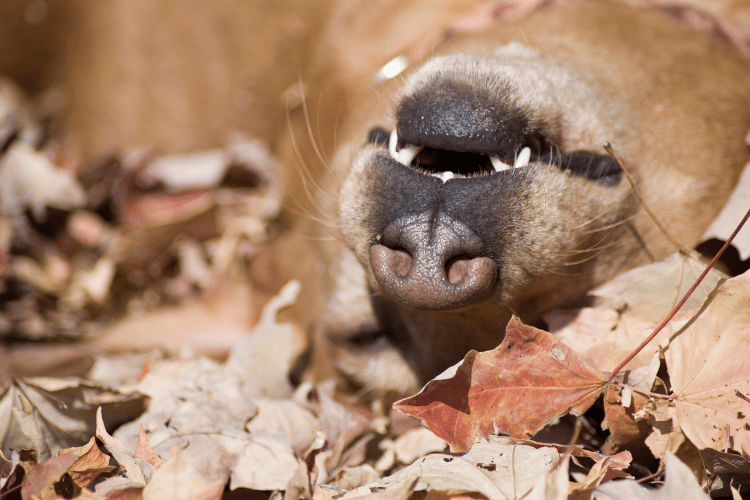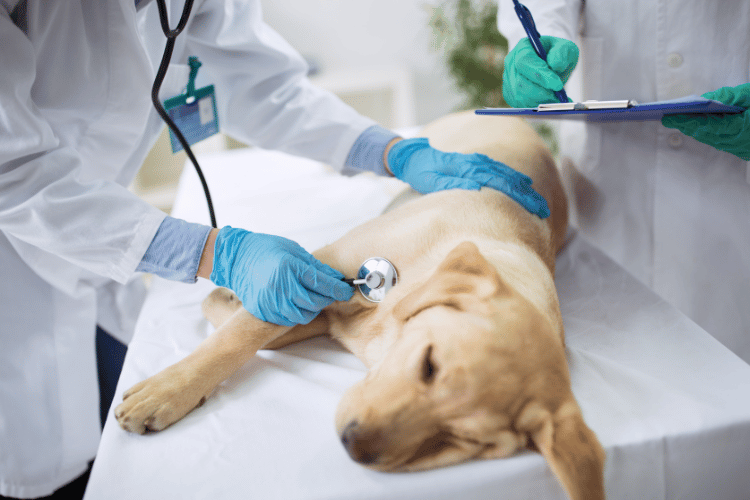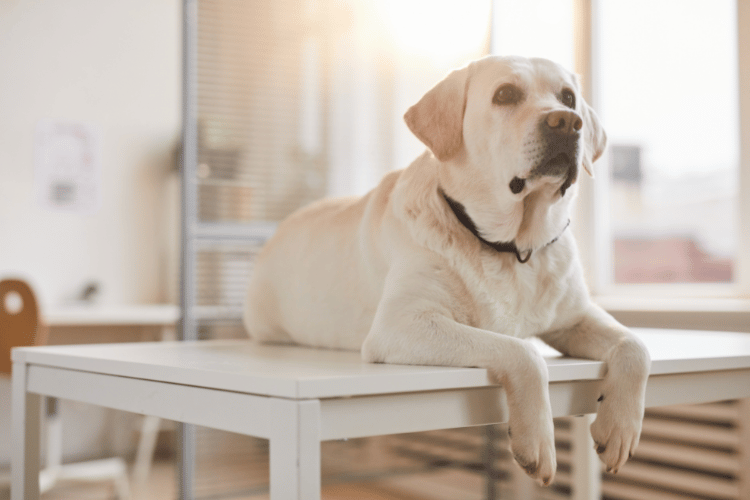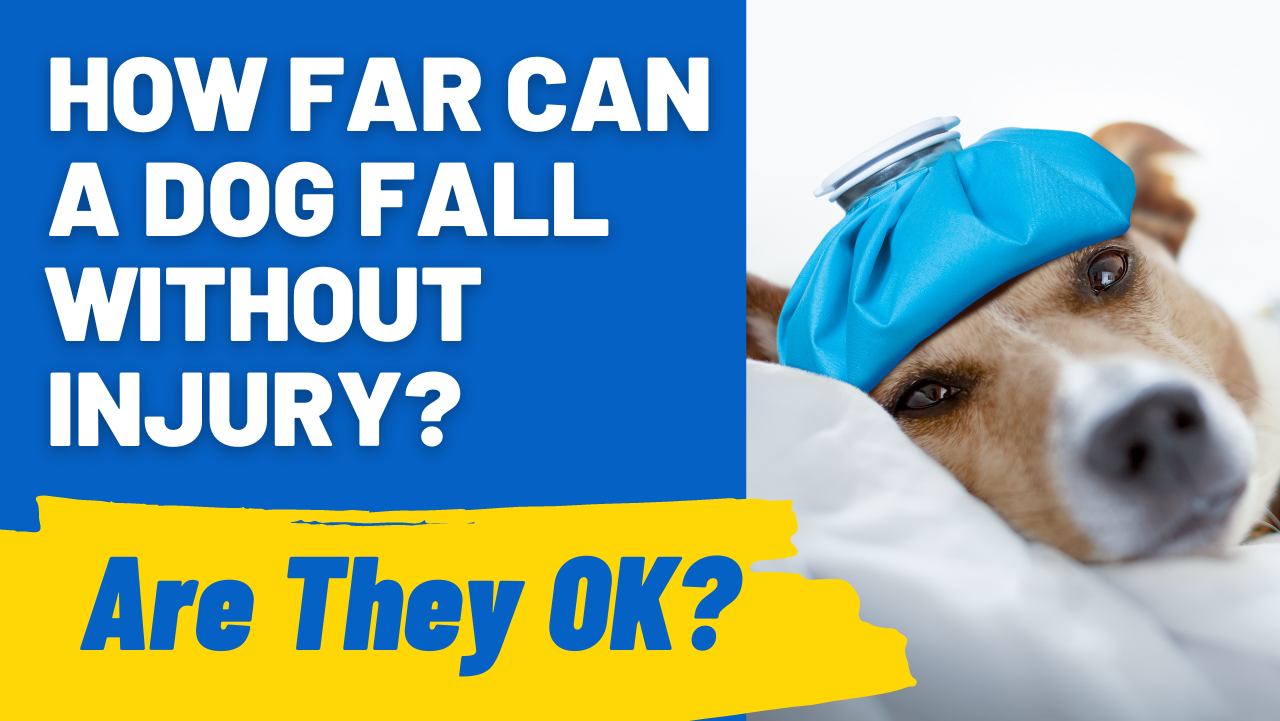Cats have a reputation for surviving falls of over 200 feet. However, dogs aren’t the same. Although you may hear some news about canines escaping unharmed after tumbling over high cliffs, it’s not the norm. So, exactly how far can a dog fall without injury?
There are many variables to consider when answering that question, such as the dog’s breed and size. That said, in general, dogs rarely live to see another day after falls of over six stories. That’s less than 100 feet.
Keep reading to find out more about dog falls and how to assess their injuries.

How Far Can a Dog Fall Without Injury?
Dogs have a chance of surviving falls from high altitudes. However, it’s quite a rare occurrence.
As reported by Newsweek, a dog named “Yogi” has fallen off a 100-foot high cliff while out for a walk. Although Yogi suffered a few injuries, the doctors believe he’s on the way to a full recovery.
In another instance, the 8-year-old dog, “Hobo,” has survived a similar 100-foot fall down a steep hill. Fortunately, as reported by ABC News, Hobo escaped this ordeal unharmed.
So, you can say that dogs may survive a 100-foot fall, but they’d be considered lucky. Mostly, people describe these types of incidents as a miracle, as they don’t happen frequently.
You might be interested in this post if it’s relevant to your situation: Dogs Falling Off Beds: Will they, and what to do if they fall.
How Do I Tell if My Dog Is Ok After a Fall?
Sometimes dogs get overly excited and may do reckless actions that result in serious injury. Generally, it can be highly concerning when your dog falls, no matter how little the distance is. Even a minor fall from the edge of the bed can hurt more than just your floof’s pride.
Ideally, it’s essential to remain calm to be able to assess your dog’s condition after a fall. That’s because if you panic, your canine is more likely to feel stressed.
Start by looking for any sign of visible injury calmly, and avoid touching your dog while doing so. However, if you’re worried about some sort of a non-visible internal injury, consulting your vet is the proper action.
Overall, exhibiting the following behaviors means that your dear doggo is fine.
- Being calm and looking ok
- Having no cuts or scrapes
- Walking, breathing, and eating normally
- Having ordinary colored gums
- Remaining active
How Do I Tell if My Dog Is Hurt From a Fall?
Accidents happen, and your dog isn’t always as safe as you might think. Even falling from low altitudes can be dangerous, especially for smaller dogs. Toy breeds, for example, can break a limb just by jumping off a couch.
Injuries your canine can suffer from after a fall include:
- Sprains
- Broken or fractured bones
- Head trauma
- Chest or abdominal injuries
- Concussion
Alarming Signs After a Fall
After any fall, you have to observe your dog for at least two days. That’s because some injuries may not show signs until a few hours after the incident. So, even if the fall doesn’t seem that significant, your dog exhibiting the following should concern you.
- Hesitation toward standing or walking
- Yelping in pain when lying down or standing up
- Limping for more than five minutes after the fall
- Funny posture or walk
- Increased breathing rate or heavy breathing
- Pale or white gums
- Whining
- Lower than usual appetite
- Drowsiness or weakness
Should I Be Worried if My Dog Fell Down?

Actually, dog falls can be quite dangerous. That’s why you should get your dog medically evaluated by a vet immediately after any incident. While you prepare to do so, here are some steps to follow:
Step #1: Address the Wounds
If you notice any visible wounds on your dog’s body after falling, you should act fast. Moreover, if your precious pet is bleeding, try not to panic. Here are a few tips on how to deal with any kind of wound.
- Wrap a clean cloth around the wound to prevent contamination, especially if there’s a broken bone sticking out.
- Apply pressure on any bleeding wound using a clean towel, and don’t remove it.
- If the towel becomes soaked with blood, put an extra towel over it so as not to disturb the clot.
- Expect the bleeding to stop within five to ten minutes (it may take longer if your dog has a clotting disorder).
Step #2: Be Careful Transporting Your Dog
Be careful when trying to carry your dog to the car after falling. That’s because you want to avoid further damage, especially if your dog suffers from broken ribs. Here’s what to do:
- If your dog is small, support the body from the area between the front and back legs, then carry your pup to the car gently.
- If you have a large dog, try to make a support sling or use a piece of wood as a stretcher.
- Try to keep your dog as still as possible to avoid complications (like lung puncture).
- Be ready to perform CPR or supply ventilation in case your dog stops breathing.
Step #3: Visit Your Vet
Remember to provide an accurate description of your dog’s fall to the vet. Furthermore, mention in detail all the signs of injury you noticed and the first aid you performed. It’s also helpful to inform the vet about your dog’s past surgeries or incidents.
After running some tests and taking the necessary procedures, your vet should give you all instructions to follow. Although it may be better for your dog to stay for observation, the vet may allow him to return home if the case isn’t serious.
Should I Let My Dog Sleep After a Fall?
The major concern when dogs fall is head trauma leading to a concussion. If you suspect this is the case, you shouldn’t allow your pup to sleep for a few hours after the incident. That’s to be able to notice any unusual symptoms, such as being lethargic.
Having said that, don’t try to keep your dog awake for extended periods because it can lead to stress. So, if you can’t assess your dog’s situation after a head trauma, it’s better to consult your vet.
How Do I Know if My Dog Is Ok After Hitting His Head?
Dogs have thick skulls. Nonetheless, they still can get concussions after a fall on the head, especially smaller breeds with short skulls.
Therefore, if you have a dog of such size, you should definitely pay a visit to the vet after experiencing head trauma. This applies even if your little fur ball isn’t exhibiting any symptoms.
Signs showing your doggo is ok after hitting his head include:
- Being alert and active
- Acting normally
- Eating and breathing fine
- Walking in an ordinary way
- Having a regular bowel movement
How Do I Know if My Dog Hit His Head Too Hard?

Dogs hitting their heads too hard may lead to a concussion. Since most symptoms don’t appear instantly, it can take time to figure it out. Averagely, signs of illness may appear within a few hours. However, some symptoms take days to surface.
Be careful, though. Your dog might just be too upset to act normal. This, in turn, may give you a false impression of concussion. That’s why it’s critical to remain composed and try to calm your puppy down.
Common concussion symptoms in dogs include the following.
- Nose or ears bleeds
- Visible injury on the head
- Abnormalities in the eyes (no dilation or odd dilation)
- Loss of consciousness
- Difficulties in walking, standing, or breathing
- Excessive drooling
- Immobility or paralysis
- Vomiting, loss of appetite, or uncontrollable bowel movement
- Shaking or seizures
A Final Thought
Sometimes dogs behave unpredictably. That’s why you should teach your pet dog that jumping from high surfaces isn’t always ok. In some cases, fall injuries can be dangerous and sometimes even life-threatening. That said, how far can a dog fall without injury?
Dogs aren’t as flexible as cats, and falling from high altitudes can cause serious damage. So, the answer to that question isn’t precise. While some dogs survive a 100-foot fall, others can break a limb falling from the couch.
In all cases, you should be aware of what to do if your dog falls and the symptoms to watch out for.
Finally, always keep your precious fur ball on a leash when having a walk in the wild.




